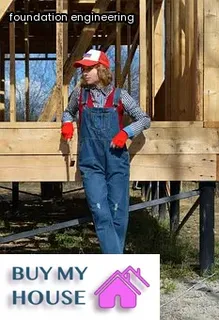Foundation cracks can be caused by many different factors. The most common are soil settling, soil erosion, tree roots, poor construction practices, and excessive loads on the foundation.
Soil settling occurs when the weight of a home or building is not evenly distributed on the soil beneath it. This can cause the soil to settle unevenly, resulting in foundation cracks.
Soil erosion can occur when rainwater washes away supporting soils underneath a foundation, causing it to sink and crack. Tree roots growing too close to a foundation can also cause damage as they expand and contract with changes in moisture levels.
Poor construction practices such as using insufficient footings or inadequate concrete mix can also result in cracks forming over time due to increased stress on the foundation walls. Lastly, excessive load from heavy equipment or vehicles parked near a building’s perimeter may overload a foundation and lead to cracking.

Foundation damage is one of the most common problems faced by homeowners, and it can be difficult to identify the source of the issue. Knowing how to spot signs of foundation damage is key to getting on top of the problem as soon as possible.
Common signs of foundation damage include horizontal, vertical and stair-step cracking in walls or floors, sloping or uneven floors, bowing walls, and gaps between your doors and windows. Additionally, water seeping into basements or crawl spaces from cracks in the floor or walls can also be a sign that there are structural issues with your home’s foundation.
Smaller foundation problems can often be fixed with caulking and other sealants, while larger more severe cracks may require professional repair. It is important to act quickly when you see any of these signs, as unchecked foundation damage can cause further issues down the line such as mold growth or insect infestations.
The key to curing foundation issues is in identifying the different types of cracks that can occur and determining the best repair solution. Foundation cracks are generally divided into two categories: structural and non-structural.
Structural cracks are those that affect the integrity of the building, while non-structural cracks do not pose any direct risk to the structure. Common causes of structural cracks include poor soil conditions, inadequate drainage, and extreme weather conditions such as flooding or drought.
Non-structural cracks can be caused by normal settling of the home due to changes in temperature or moisture levels. Repair solutions vary depending on the type and size of crack, but generally involve filling or sealing the crack with concrete or epoxy.
In some cases, it may be necessary to replace part of the foundation or add additional support beams for maximum stability. If you suspect your home has a foundation issue, it's important to consult an experienced professional for an accurate diagnosis and repair plan before any major damage occurs.

Foundation cracks can be a major source of concern for homeowners and property owners. Identifying the type of crack is an important part of assessing the damage and determining the best repair solution.
Horizontal cracks are often caused by water pressure or soil expansion, while vertical cracks are typically due to settlement or shrinkage in the foundation. Stair-step cracks can occur when there is a change in material between two different sections of wall, such as concrete and brick.
If a crack extends from one side of the foundation to the other, it may indicate a more serious problem that requires professional attention. Nonstructural hairline cracks can usually be repaired with epoxy injection or caulking, while larger structural cracks may require more extensive repairs like steel reinforcements or underpinning.
Regardless of the type of crack, it’s important to identify and address any issues with your foundation quickly to avoid further damage over time.
When evaluating a foundation for potential problems, it is important to identify and understand the different types of cracks that might be present. Horizontal cracks are often caused by exterior pressure, while vertical cracks indicate settling issues.
Stair-step cracks may indicate poor construction or shifting soil, while diagonal cracks can be caused by both interior and exterior factors. When assessing a foundation, it is also necessary to look for signs of water damage; this could include efflorescence or rust on metal surfaces, as well as wood rot and mold growth.
If any of these issues are present, the cause must be identified in order to determine the best repair solution. In some cases, this may involve underpinning or shoring up the foundation with additional support beams or columns; other solutions may include filling existing gaps with cement mortar or epoxy injection.
Regardless of the repair needed, it is critical that all steps are taken to ensure the safety and longevity of your home's foundation.

Inspecting basements for structural integrity is an important part of home maintenance. Basement walls are particularly vulnerable to foundation cracks, which can cause serious damage if left unchecked.
Identifying different types of cracks and taking the necessary steps to repair them is essential for ensuring the structural integrity of the basement. Common types of foundation cracks include vertical, horizontal, stair-step, and diagonal cracks.
Vertical cracks often indicate a problem with the soil outside the wall and may need to be filled or stabilized with concrete or epoxy injections. Horizontal foundation cracks may occur when there is pressure on one side of the wall that exceeds what it was designed to bear.
Stair-step and diagonal cracks usually indicate foundational settlement due to insufficient support at the base. Repair solutions for these types of foundation problems include underpinning, mud jacking, and helical piers depending on their severity and location.
Properly identifying and repairing basement foundation cracks is essential for preserving the structural integrity of any home or building.
Diagnosing the severity of a foundation crack is an important step to take when assessing the damage sustained and determining what type of repair solution is necessary. The first step in identifying how serious the crack is, is to determine whether or not it is actively growing.
Active cracks can be identified by looking for fresh mortar, dust, or water seeping through the wall. Another way to identify active cracks is by comparing both sides of the crack with one another.
If the gap between them increases over time, then it’s likely that it’s getting bigger and more serious. Static foundation cracks, on the other hand, are those that have not grown and remain unchanged over time.
These types of cracks can often be sealed to help protect against water infiltration and further damage. Once you have identified which type of crack you are dealing with, you can move onto assessing its severity and finding a suitable repair solution.
The size, width and depth should all be taken into account as they will all affect which repair option will work best for your particular situation.

Foundation cracks can be caused by a variety of factors, but soil conditions are a frequent culprit. Soil composition and moisture levels play an important role in determining the stability of a foundation and when these factors are out of balance, it can lead to serious issues.
Poorly compacted soil or shifting ground due to changes in moisture content can cause foundations to settle unevenly, creating structural damage such as cracks, gaps and separations. In addition to this, soil erosion or expansion due to water infiltration can also lead to cracked foundations.
It is important for homeowners to assess the impact of soil conditions on their foundation before attempting any repairs, as failing to do so could lead to further damage down the line. A professional engineer should be consulted if the underlying issue is related to soil composition or moisture levels and the appropriate repair solutions implemented based on their recommendations.
When troubleshooting water issues that are affecting your foundation, it is important to be aware of the different types of foundation cracks and repair solutions. Horizontal cracks can indicate expansive soils that swell due to increased moisture, while vertical cracks often result from poor workmanship or settling.
If you notice any hairline cracks, these may be caused by temperature changes or normal shrinkage of the concrete. If there is a bulge in the wall, this could mean hydrostatic pressure has built up due to a blocked drain or insufficient drainage around the foundation walls.
Another common problem is efflorescence, which appears as a white powdery substance on basement walls and is typically caused by excessive moisture seeping through porous masonry walls. To address these issues, some simple repair solutions include waterproofing exterior walls with a sealant or coating, installing interior drainage systems such as sump pumps or French drains, backfilling with gravel for better soil drainage, and using dehumidifiers to keep moisture levels under control.

Foundations are the most important part of a building, as they provide the structural support for everything else. As such, it is essential to regularly inspect and maintain foundations to ensure that any potential issues are addressed before they become a larger problem.
Foundation cracks can be caused by a variety of factors, including soil movement, groundwater infiltration, or even building settlements. It is important to identify what type of crack is present in order to determine the best course of action for repair.
Building settlements occur when the soil underneath the foundation shifts due to natural causes such as drought or flooding, resulting in cracks appearing in the foundation walls and floors. These types of cracks often look like a stair-step pattern and will have jagged edges at the base where they meet the flooring.
The best solution for repairing foundation settlement cracks is to use concrete patching products specifically designed for this purpose. This type of repair usually involves injecting an expanding foam between gaps in order to stabilize them and prevent further settlement damage from occurring.
Foundation cracks can be a serious issue, but they don’t always require extensive and costly repairs. Identifying the type of crack present is essential in determining the repair solution most suitable for that particular situation.
Horizontal cracks indicate problems with water or soil pressure and should be addressed immediately to avoid further damage. Vertical cracks often occur when the foundation settles and may not need to be repaired if they are not growing in size.
Diagonal or stair-step cracks usually result from movement of the foundation or poor construction. Stucco, caulking, epoxy injections and wall anchors are all viable repair solutions depending on the severity of the crack and the cause behind it.
Taking proper steps to identify the type of foundation crack present can help homeowners prevent more expensive repairs down the road.

Identifying concrete slab and wall cracks is an important part of understanding the kind of foundation damage that your property may have experienced. Foundation cracks can be caused by a variety of things, including water pressure and soil settling.
To identify these kinds of cracks, look for horizontal or stair-step patterns; if you find any, it's likely that they were caused by external pressures on the foundation wall or slab. Vertical cracks in walls are usually signs of settlement or shifting soil beneath the foundation, while diagonal cracks indicate that there is some sort of structural problem with the foundation itself.
If you see any hairline vertical cracking in slabs, that could also be indicative of shrinkage due to dryness or curing. Fortunately, there are repair solutions for all types of foundations cracks; however, it is important to identify which type you have before you begin any repairs so that you can choose the most appropriate solution.
Foundations are susceptible to uneven settling which can lead to costly repairs if not addressed quickly. It is essential to identify the different types of foundation cracks and repair solutions to minimize this issue. Common types of foundation cracks include vertical, stair-step, horizontal, and diagonal.
Vertical cracks can be caused by structural damage or settlement of the soil beneath a home's foundation. Stair-step cracks form when one side of the foundation settles more than other side resulting in an uneven surface. Horizontal cracks occur due to pressure from overloading the foundation or due to hydrostatic pressure from water buildup around it.
Diagonal cracks usually appear when both horizontal and vertical forces are at play within a structure. Repair solutions for these different types of foundation cracks include repairing with epoxy injection, patching with cementitious materials, underpinning with concrete piers or steel beams, and installing drainage systems and sump pumps around the foundation walls. Epoxy injections fill small gaps and prevent water seepage while patching with cementitious materials is used for larger areas affected by movement or heaving soils.
Underpinning with concrete piers or steel beams helps strengthen foundations that have shifted too much. Finally, installing drainage systems and sump pumps help redirect groundwater away from the home's structure thus reducing hydrostatic pressure on its walls and preventing further damage.

Concrete foundations are used in many buildings and structures, but it's important to understand the different grades of concrete before deciding which one is best for your project. Grade of concrete refers to the strength of the material and is classified into three groups: ordinary, standard, and high.
Ordinary grade concrete is suitable for most residential projects such as driveways and sidewalks since it has lower strength requirements than standard or high grade. Standard grade concrete is more durable than ordinary concrete and is usually used for foundations of walls and larger structures like commercial buildings.
High grade concrete has the highest strength rating and is often used for industrial applications where extra strength is necessary. By understanding the different grades of concrete you can choose the best option for your project.
Foundations are an important part of any structure, however they can be prone to cracking. Knowing the vulnerable areas of foundations that are more likely to crack can help property owners identify potential issues before they become major problems.
Common areas of a foundation that often experience cracking include corners, window and door openings, stairwells, and around pipes. These cracks can range in size from hairline fractures to larger structural problems that should be addressed immediately.
Identifying these cracks as soon as possible is important because it can save time and money by helping to avoid costly repairs down the line. It is also important to understand the different types of foundation cracks so you can determine the best solution for repair.
Horizontal cracks tend to indicate water or drainage issues while vertical cracks occur when walls shift due to soil movement or settling. Diagonal cracks may be caused by a combination of the two or other factors such as nearby tree roots or uneven weight distribution on the foundation wall.
With proper inspection and maintenance, homeowners can better identify potential issues with their foundations and take steps towards repairing any existing damage before it becomes too severe.

Exploring alternative methods to strengthen weak foundations is a key factor in ensuring the structural integrity of any building. While identifying different types of foundation cracks is the first step towards repair, there are a variety of solutions available for reinforcing foundations that are not necessarily costly or time consuming.
As an example, helical piers can be used to provide additional support for foundations that have been weakened due to shifting soil or other causes. In addition, steel I-beams may also be installed to reinforce existing foundations and provide stronger support.
Polyurethane foam injections are another option that can be employed to fill cracks and voids within foundation walls, helping to maintain structural integrity and prevent further damage due to weather exposure or temperature changes. Finally, underpinning is a method often used when dealing with deep foundation repair problems as it allows for greater control over the stabilization process by providing extra support from below the structure.
It is important to note however that each situation should be evaluated independently in order to determine the best course of action for strengthening weak foundations and restoring their original state.
Examining exterior clues is an important step in identifying potential foundation issues. By looking for common types of cracks, such as vertical and horizontal, or rising damp around the base of the structure, homeowners can get a better sense of the state of their foundation.
Analyzing these clues can help determine the source and cause of any foundation problems. Additionally, there are steps that can be taken to increase the durability and longevity of foundations.
This includes proper drainage, waterproofing, maintenance, regular inspections and using quality materials during construction. Weather also plays an important role in damaging foundations; heavy rain or wind can cause the soil to erode away from a structure’s base, resulting in settling and cracking.
Investing in protective measures such as underpinning can help protect against weather damage as well. Understanding all these factors is essential for determining which repair solutions are best suited for each particular situation.
Cracks in your foundation can be a sign of serious structural damage. It is important to identify the different types of foundation cracks and determine if they are serious enough to require repair.
Hairline cracks, which are typically less than 1/8 inch wide, may not be a cause for concern as these occur naturally over time due to the settling of your home’s foundation. However, wider cracks should be investigated further as they could indicate weak spots in the foundation or water damage.
These usually appear at corners or around doors and windows and can range from 1/4 inch up to one inch wide. Stair-step cracks are also concerning and usually indicate settlement issues with the soil beneath your house.
Lastly, horizontal cracks can be especially worrisome as they often point to severe structural problems that may require immediate attention. If you’re unsure whether or not a crack is serious, it’s best to consult a professional for an inspection and repair solution.

Cracks in foundation walls can be concerning for homeowners and could indicate a structural problem. Identifying the type of crack is important to determine if it requires attention or is cosmetic.
One way to tell if a crack is structural is by its shape, width, and orientation. A vertical crack that runs through the entire wall and is wider than 1/8 inch is generally considered to be a structural issue.
Horizontal cracks that are wider at one end may also be an indication of a structural problem. If a crack has jagged edges or stair-step patterns, it could also signal that the wall is under stress or moving due to settling or other issues.
Repair solutions for structural cracks include underpinning, steel reinforcement rods, epoxy injections and carbon fiber strips. Homeowners should always consult with a professional before attempting any repair solution as the wrong approach could make the problem worse.
Foundation cracks come in all shapes and sizes, but the most common types of cracks are vertical, horizontal, stair-step, shrinkage, and settlement. Vertical foundation cracks are typically caused by changes in soil moisture levels due to heavy rains or a sudden increase in water table levels.
Horizontal cracks often result from weight bearing on one side of the foundation wall. Stair-step cracks are indicative of differential settlement - when one side of the foundation has settled more than the other side.
Shrinkage cracks occur in poorly compacted soils or those with expansive clay content, while settlement is usually caused by expansive soils that swell and contract with moisture content. Repair solutions for these typical foundation cracks depend on the type and severity of the crack, but typically include either repairing or replacing damaged sections of the foundation as well as addressing any drainage issues that may have contributed to the cracking.
Foundation cracks can range from small to large and each size requires a different repair solution. Smaller hairline cracks measuring 1/8 inch or less may be cosmetic issues and not structurally damaging, but should still be monitored.
Medium-sized cracks measuring 1/4 inch or more should be inspected by a professional to determine whether they are the result of poor installation, settling or expansive soil. These types of cracks may require repairs such as epoxy injection or carbon fiber reinforcement to prevent further damage.
Larger foundation cracks measuring over 1/2 inch wide should be addressed as soon as possible and can often require foundation underpinning or wall anchors. It's important to identify the size of any potential foundation crack in order to determine the appropriate repair solution and ensure your home's structural integrity.
Are horizontal or vertical foundation cracks worse? This is an important question when it comes to identifying different types of foundation cracks and determining the best repair solutions. Horizontal foundation cracks are generally considered more serious than vertical foundation cracks, as they usually indicate a structural issue with a home’s foundation.
Horizontal cracks may be caused by soil pressure pushing against the walls of the foundation, poor construction techniques, or even erosion due to heavy rains or flooding. On the other hand, vertical foundation cracks can be caused by normal settling of a home or normal shrinkage of concrete over time.
While neither type of crack is ideal, horizontal cracks tend to be more difficult and costly to repair. Homeowners should carefully inspect their foundations for any signs of cracking and contact a professional if they see any indications of damage.
The right repair solution depends on the type and extent of the damage, so it’s important to accurately identify what kind of crack you have in order to get the job done correctly.
No, not all cracks mean foundation problems. There are many different types of foundation cracks, some of which may indicate a structural problem while others are simply cosmetic in nature.
Identifying the type of crack is the first step in determining the best repair solution. Horizontal foundation cracks are often caused by soil pressure or hydrostatic pressure and can be repaired with helical piers or wall anchors.
Vertical foundation cracks usually require epoxy injections to fill and seal the crack. Stair-step cracks, which usually form at the corners of masonry foundations, can be prevented by keeping masonry walls free from moisture and by adding additional support beams to reinforce the structure.
Hairline cracks in concrete block foundations may need to be waterproofed but do not require extensive repairs. By recognizing and properly identifying different types of foundation cracks, you can make an informed decision about how to best protect your home's foundation for years to come.
A: The most common types of foundation cracks include horizontal, stair-step, vertical, and U-shaped.
A: The four types of foundation cracks are Horizontal Cracks, Vertical Cracks, Diagonal Cracks, and Stair-Step Cracks.

A: Shrinkage cracks are a common type of foundation crack that can be caused by the shrinking and drying out of building materials such as concrete, mortar, and stucco.
A: Vertical or stair-step cracks in the foundation walls, horizontal cracks at the top of the foundation wall, and diagonal cracks are all signs of a structural problem with the foundation.
A: Foundation cracks can be classified into four main categories: Horizontal Cracks, Vertical Cracks, Diagonal Cracks, and Stair-Step Cracks.

A: Shrinkage cracks are a sign of structural damage and require professional inspection to determine the appropriate repair solutions. Additionally, waterproofing solutions may be necessary to protect the foundation from further damage.
A: Large horizontal cracks, stair-step cracks, and diagonal cracks are all types of foundation cracks that can indicate more serious structural issues with a building's foundation.
A: Foundation cracks can be classified into four main categories: Hairline Cracks, Vertical Cracks, Diagonal Cracks, and Stair-Step Cracks.
A: Epoxy injection repair is typically used to fix heaving cracks caused by expansive soil damage.